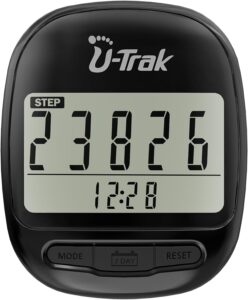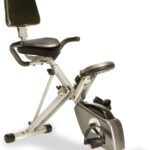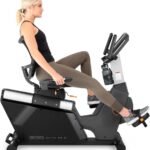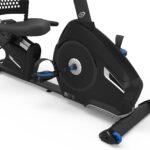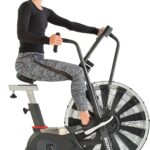A recumbent bike is an exercise tool that allows people to lose body fat, strengthen their muscles and increase their overall fitness. As of today, it is becoming a popular choice among the people due to its benefits over a traditional exercise bicycle. When compared to a standard bicycle, a recumbent bike places its users in a reclined position- (almost like they’re laying down) instead of a seating position.
This design intervention allows for a more ergonomic control over the bike, which overall enhances the user’s comfort and productivity. While recumbent bikes sound convenient they also have a significant number of flaws. Are you new to the exercise business and want to know how many calories burned on a recumbent bike? Read on to find out!
How Many Calories Can I Burn?
You cannot exactly determine the total number of calories burned on a recumbent bike, this is highly dependent on the kind of regime you set. A 30 minute workout combined with a calorie deficit can be highly effective. If you’re a beginner try to start with the lowest setting of 50 rpm and move up to a speed of 80 to 100 rpm. On an average you can burn anywhere from 300 – 700 calories depending on your body weight, intensity and resistance of the workout. Therefore, if you have a standard weight of 130 – 140 lbs, cycling at a speed between 12 to 14 miles per hour, expect to burn around 260 calories. If you are heavier you will burn more of course.
A recumbent bike can also be beneficial for greater calorie loss as it targets stubborn subcutaneous fat. By adjusting the seat and moving it closer to the handle, the amount of work exerted by the legs is significantly minimized and the amount of work exertion of lower abdominal muscles is increased. Since these are some of the hardest muscle groups to work on, focusing on them will allow for a greater calorie burn as well as the lean looking stomach of your dreams.
Advantages of Recumbent Bikes
Since Recumbent exercise bikes require their users to lie on the machine, they allow for a better distribution of the body weight which makes it more comfortable than a traditional exercise bike. The seats also offer a broad surface area along with a back-rest which prevent any potential back injuries or pain. This can also be an advantage for people who tend to exert effort from their backs instead of their legs. Ultimately, it will lead to a better targeting of the limbs you want to work on while avoiding the strain.
In case you’re more towards the older spectrum of age or have medical issues that prevent you from balancing or exercising correctly, a recumbent bike can also help you with that too. Since the bike is closer to the ground it allows for a lowered center of gravity that increases the stability of the person on the bike. As for the fitness potential it has, recumbent bikes allow for an overall targeting of different groups of muscles. Unlike traditional bikes which particularly aim towards muscles in the legs, a recumbent bike allows you to target the abdomen too which helps you lose weight all over the body.
It can also be helpful in burning more calories as the machine is more comfortable leading to less tiredness thus pushing you to spend more time on the machine. You will also save time as you wouldn’t have to spend more time extra ab workouts or lunges afterwards. Moreover, since your hands are free you can always use your phone to listen to music or read an article while your legs are doing the work. Strengthen your core is ever the yet more effective and easy with this tool.
Read: how long on exercise bike to lose weight and burn 500 calories
The Setbacks with a Recumbent Bike
While Recumbent bikes are a great option for anyone looking to shred that belly with minimal effort, it does come with a few disadvantages. To begin with, the cost of this equipment is significantly higher than a standard exercise bike. The price can be anywhere from $600 to $1000 whereas a stationary bike can be bought for lower.
Furthermore, a recumbent bike takes up much more space than a stationary bike. Since the machine requires you to lie down, it will take a considerable amount of space in your house. Also, it’s not very compact so you will face issues in storing it away. Another point to note is that while these bikes promote overall muscle engagement they may not allow you to optimally engage your core muscles like a stationary bike does. This is because you’re required to lay down which causes you to not utilize your full body weight to peddle. The overall result is disengagement of your core muscles hence efficiency of burning calories is greatly minimized.
Safety measures before using recumbent bikes
It is imperative that you spend 5 to 10 mins warming up before you start pedaling on an exercise bike. This can include any form of stretches, light jogging or brisk walking. It will help you sustain a longer workout by prepping your muscles and ensure that there’s a less likelihood of injuries. Remember to maintain a firm and straight posture when starting out, leaning forwards will disturb the weight distribution and call for some fatigue later on. Proper posture can help with total calories burned on a recumbent bike.
Other Advice
Before trying out a new fitness trend always consult a specialist or a physiotherapist. Especially if you have issues that limit your capability to exercise it is vital that you seek medical advice.
Read: Does Cycling Give You a Flat Stomach?
Final Thoughts
A recumbent bike is a great option for users that have limitations but still want to keep their fitness game up. The machine can effectively lower issues like back pain, knee stiffness and soreness while allowing you to burn calories at the same time. Depending on your tolerance, health and weight loss goals, you should research the right kind of recumbent bike for you. Also, it’s important to note that while it does offer a significant amount of disadvantages, according to users, it is a better investment in the long run.,
